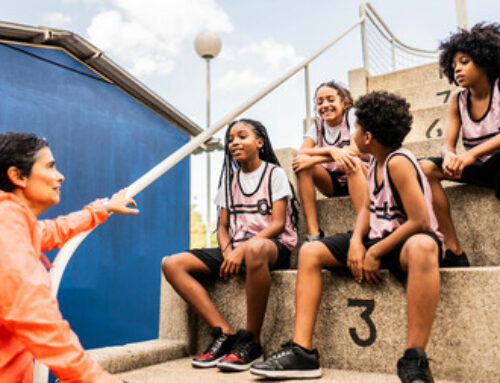More ‘Us,’ Less ‘Them’: What Championship Teams Focus On
What do you want from your athletes on game day? The coaches we consult will often begin with broad concepts like “win” or “compete at a high level.” These are great starting points.
But after further discussion, we are often able to break those ideas down into smaller components. Eventually, we find teams’ goals fall within with a few core categories—execution, motivation and resilience. And quite often, team’s pitfalls come from a lack of intense focus on themselves. Here are the culture factors that separate championship teams from the mediocre.
Champions Don’t Execute By Accident
Game plans and strategies rely on the athletes’ execution. That’s an inescapable truth. Well-executed plans can make play-callers look like geniuses; poorly executed plans can make geniuses look like fools. With that in mind, coaches would be well served to focus on their teaching—and their players’ level of understanding—as they construct their strategies. Time after time, coaches enter games reporting a high level of confidence in their plan, but find themselves frustrated when athletes fail to “do what [they] were coached to do!”
So teach. Teach for understanding. Go as slow as necessary to get the building blocks in place. The “castle” of your brilliant game plan will crumble without a solid foundation. We find that coaches, in sincere desire to compete at a high level and do right by their athletes, will build metaphorical towers and turrets, hoist flags and install drawbridges, before the foundation has been laid. You don’t need trick plays in Week 1, and who cares if you “install the whole playbook” when your athletes still don’t know how to execute your bread-and-butter calls?
We visited a football program in the summer of 2018 who, six weeks in, had a startlingly large number of athletes who did not know basic information (the names of all 11 defensive positions, how many deep zones there were in Cover 2, etc.). Their top level ability as a team was clearly limited by a shoddy foundation.
The good news is that once this became clear to coaches, they were able to slow down and fill the cracks. What they ended up building was a team that came within a few points of a conference championship. There is no way of knowing exactly where the team would have finished had they not identified this issue, but coaches said a re-dedication to the basics led their execution to “skyrocket.” While they admit that it took a while to get used to the slower pace of classroom and field time, what they ended up with was a team that understood, and could thereafter execute on their understanding.
This team’s coach admitted that he and his staff “got so focused on [the opponent in their opening game] we didn’t think to check what the kids know… just because we get it doesn’t mean that they do.”
The next step is to teach for versatile understanding. Ask your athletes to execute in a variety of circumstances and situations. Run a play under a time crunch. Simulate a last-minute substitution and run the play with second-string players. Turn the music up and the play clock or shot clock down, get the team shouting and cheering, blow some whistles, hit the bullhorn, whatever you want. Are they still able to perform?
If the stress of the moment limits execution, turn the stress down to ensure understanding. When they have it, turn the stress and complexity back up until you find the next pinch point where execution drops off. Then repeat. Never undervalue understanding. You cannot execute beyond your understanding unless it’s on accident. Championship programs are never built on accident.
Eventually, you will need to take the other team into consideration. But the order of operations holds strong: You must take care of us before you even consider them.
Champions Are Fueled by Love
This is where we most often find coaches relying on “othering” techniques. In an effort to motivate a team, coaches often villainize their opponents, pitting one faction of adolescent warriors against another. And guess what…it works. Kinda. Talking about the enemy at the gate can stimulate psychological and physiological responses.
When we hype people up to battle opponents, we are using language to elicit a sympathetic nervous system response. In this state, heart rate increases, rate of respiration increases, pupils dilate and blood glucose levels increase so that muscles will have quick access to fuel. In the appropriate doses, it can have a very positive effect.
The response is triggered by the most “animal” parts of our brain—the parts of our brain responsible for living, breathing, fighting, fleeing and staying alive. They are necessary. But as those animal areas are on fire, the parts of our brain which make us uniquely ‘human’ can be compromised. Crossing a threshold here will make high level processing and analysis very difficult.
Coaches, do you want your athletes to be willing to run through a wall, or do you want them to properly execute a play? To this, many coaches will respond, “both.” Fair. But once again, the order of operations is clear: execute the play, with intensity. Intensity aimed in the wrong direction is what we call a broken play.
So how do we motivate to the ideal level? Try encouraging the idea of playing for each other, rather than playing against them. If you make competition more about executing to the best of your ability for the sake of your brothers/sisters on your team, then you open the door to analysis, communication and high-level execution. Successful sports cultures rely on those abilities.
The other idea to consider is that the enemy-from-the-next-town-over narrative does not always resonate. For some, this will not provide “motive” in the ways we might assume. A coach who has 30-40 years of experience might have developed a distaste for the cross-town rival that a young person competing in the rivalry for the first time might not understand. Or if they do, it would certainly not be an understanding of the same depth.
What every player has the potential to understand is the value of the person standing next to them. They understand that the person they are in the locker room with is important. They can easily understand that the person they share a seat on the bus with is important.
Once again, to play for one’s teammate instead of against the opponent is a motivation that will hold.
The other benefit of motivating in this way is that it allows an athlete to be more resilient. In any meaningful competition, there will come a point when things are not going exactly as planned. Resilience is an essential capacity to perform at a high level.
If a young person’s core motivation is one of anger, driven solely by the desire to vanquish a villainized opponent, then it is a shallow and unsteady one. What can be built on a bedrock of hate? A shaky castle, at best.
But if you cultivate a strong core consisting of purpose, gratitude and playing for your teammates, then there will be a solid foundation to build on. If you want your athletes to be resilient, this is essential.
To be resilient, to continue on during difficult times, as the environment varies, you will have to return to that bedrock. To paraphrase psychologist and UC Berkeley professor Rick Hanson, resilience depends on the ability to fall back on internalized experiences of well-being. Those build inner strengths, which in turn make you more resilient. Without those inner kindnesses, the psychological ground will shake.
So if you want to motivate your athletes, and if you want them to be resilient, teach them to be the best version of themselves in service to their teammates. If you teach them to be their most intense self in order to demolish their opponent, then you will get the result you are looking for now and then, but it will often backfire in the form of penalties, wavering resiliency and faulty execution. Championship programs don’t bank on being good “now and then.”
What Are You Leaving Them With?
They say that sports teach life lessons. Do you agree? If so, what life lessons are you teaching?
When using sports to prepare people for their lives, it is essential to name your purpose. Name your goal then ask yourself if your behaviors map on to that.
We hear coaches saying that they want their athletes to be better brothers and sisters, better mothers and fathers, better employees and leaders. When you get in conflict with your spouse, villainizing them does not seem like a transferrable approach. When negotiating a business deal, trying to “tear their throats out” is probably not the appropriate instinct. If you’re working on a big project and you try to jump ahead and skimp on the basics, things aren’t going to turn out well.
If you want your athletes to execute the game plan effectively, stay motivated, and demonstrate resilience, then focus on enhancing your team more than worrying about an opponent. Doing so will give you the best opportunity to win and compete at a high level, but also better prepare them for life.
Photo Credit: fredrocko/iStock
READ MORE:
RECOMMENDED FOR YOU
MOST POPULAR
More ‘Us,’ Less ‘Them’: What Championship Teams Focus On
What do you want from your athletes on game day? The coaches we consult will often begin with broad concepts like “win” or “compete at a high level.” These are great starting points.
But after further discussion, we are often able to break those ideas down into smaller components. Eventually, we find teams’ goals fall within with a few core categories—execution, motivation and resilience. And quite often, team’s pitfalls come from a lack of intense focus on themselves. Here are the culture factors that separate championship teams from the mediocre.
Champions Don’t Execute By Accident
Game plans and strategies rely on the athletes’ execution. That’s an inescapable truth. Well-executed plans can make play-callers look like geniuses; poorly executed plans can make geniuses look like fools. With that in mind, coaches would be well served to focus on their teaching—and their players’ level of understanding—as they construct their strategies. Time after time, coaches enter games reporting a high level of confidence in their plan, but find themselves frustrated when athletes fail to “do what [they] were coached to do!”
So teach. Teach for understanding. Go as slow as necessary to get the building blocks in place. The “castle” of your brilliant game plan will crumble without a solid foundation. We find that coaches, in sincere desire to compete at a high level and do right by their athletes, will build metaphorical towers and turrets, hoist flags and install drawbridges, before the foundation has been laid. You don’t need trick plays in Week 1, and who cares if you “install the whole playbook” when your athletes still don’t know how to execute your bread-and-butter calls?
We visited a football program in the summer of 2018 who, six weeks in, had a startlingly large number of athletes who did not know basic information (the names of all 11 defensive positions, how many deep zones there were in Cover 2, etc.). Their top level ability as a team was clearly limited by a shoddy foundation.
The good news is that once this became clear to coaches, they were able to slow down and fill the cracks. What they ended up building was a team that came within a few points of a conference championship. There is no way of knowing exactly where the team would have finished had they not identified this issue, but coaches said a re-dedication to the basics led their execution to “skyrocket.” While they admit that it took a while to get used to the slower pace of classroom and field time, what they ended up with was a team that understood, and could thereafter execute on their understanding.
This team’s coach admitted that he and his staff “got so focused on [the opponent in their opening game] we didn’t think to check what the kids know… just because we get it doesn’t mean that they do.”
The next step is to teach for versatile understanding. Ask your athletes to execute in a variety of circumstances and situations. Run a play under a time crunch. Simulate a last-minute substitution and run the play with second-string players. Turn the music up and the play clock or shot clock down, get the team shouting and cheering, blow some whistles, hit the bullhorn, whatever you want. Are they still able to perform?
If the stress of the moment limits execution, turn the stress down to ensure understanding. When they have it, turn the stress and complexity back up until you find the next pinch point where execution drops off. Then repeat. Never undervalue understanding. You cannot execute beyond your understanding unless it’s on accident. Championship programs are never built on accident.
Eventually, you will need to take the other team into consideration. But the order of operations holds strong: You must take care of us before you even consider them.
Champions Are Fueled by Love
This is where we most often find coaches relying on “othering” techniques. In an effort to motivate a team, coaches often villainize their opponents, pitting one faction of adolescent warriors against another. And guess what…it works. Kinda. Talking about the enemy at the gate can stimulate psychological and physiological responses.
When we hype people up to battle opponents, we are using language to elicit a sympathetic nervous system response. In this state, heart rate increases, rate of respiration increases, pupils dilate and blood glucose levels increase so that muscles will have quick access to fuel. In the appropriate doses, it can have a very positive effect.
The response is triggered by the most “animal” parts of our brain—the parts of our brain responsible for living, breathing, fighting, fleeing and staying alive. They are necessary. But as those animal areas are on fire, the parts of our brain which make us uniquely ‘human’ can be compromised. Crossing a threshold here will make high level processing and analysis very difficult.
Coaches, do you want your athletes to be willing to run through a wall, or do you want them to properly execute a play? To this, many coaches will respond, “both.” Fair. But once again, the order of operations is clear: execute the play, with intensity. Intensity aimed in the wrong direction is what we call a broken play.
So how do we motivate to the ideal level? Try encouraging the idea of playing for each other, rather than playing against them. If you make competition more about executing to the best of your ability for the sake of your brothers/sisters on your team, then you open the door to analysis, communication and high-level execution. Successful sports cultures rely on those abilities.
The other idea to consider is that the enemy-from-the-next-town-over narrative does not always resonate. For some, this will not provide “motive” in the ways we might assume. A coach who has 30-40 years of experience might have developed a distaste for the cross-town rival that a young person competing in the rivalry for the first time might not understand. Or if they do, it would certainly not be an understanding of the same depth.
What every player has the potential to understand is the value of the person standing next to them. They understand that the person they are in the locker room with is important. They can easily understand that the person they share a seat on the bus with is important.
Once again, to play for one’s teammate instead of against the opponent is a motivation that will hold.
The other benefit of motivating in this way is that it allows an athlete to be more resilient. In any meaningful competition, there will come a point when things are not going exactly as planned. Resilience is an essential capacity to perform at a high level.
If a young person’s core motivation is one of anger, driven solely by the desire to vanquish a villainized opponent, then it is a shallow and unsteady one. What can be built on a bedrock of hate? A shaky castle, at best.
But if you cultivate a strong core consisting of purpose, gratitude and playing for your teammates, then there will be a solid foundation to build on. If you want your athletes to be resilient, this is essential.
To be resilient, to continue on during difficult times, as the environment varies, you will have to return to that bedrock. To paraphrase psychologist and UC Berkeley professor Rick Hanson, resilience depends on the ability to fall back on internalized experiences of well-being. Those build inner strengths, which in turn make you more resilient. Without those inner kindnesses, the psychological ground will shake.
So if you want to motivate your athletes, and if you want them to be resilient, teach them to be the best version of themselves in service to their teammates. If you teach them to be their most intense self in order to demolish their opponent, then you will get the result you are looking for now and then, but it will often backfire in the form of penalties, wavering resiliency and faulty execution. Championship programs don’t bank on being good “now and then.”
What Are You Leaving Them With?
They say that sports teach life lessons. Do you agree? If so, what life lessons are you teaching?
When using sports to prepare people for their lives, it is essential to name your purpose. Name your goal then ask yourself if your behaviors map on to that.
We hear coaches saying that they want their athletes to be better brothers and sisters, better mothers and fathers, better employees and leaders. When you get in conflict with your spouse, villainizing them does not seem like a transferrable approach. When negotiating a business deal, trying to “tear their throats out” is probably not the appropriate instinct. If you’re working on a big project and you try to jump ahead and skimp on the basics, things aren’t going to turn out well.
If you want your athletes to execute the game plan effectively, stay motivated, and demonstrate resilience, then focus on enhancing your team more than worrying about an opponent. Doing so will give you the best opportunity to win and compete at a high level, but also better prepare them for life.
Photo Credit: fredrocko/iStock
READ MORE:












